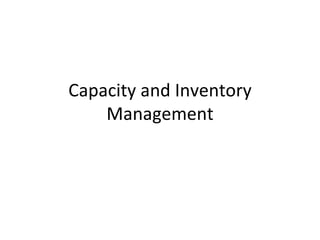Capacity & Inventory Management
•Download as PPT, PDF•
3 likes•9,208 views
Report
Share
Report
Share

Recommended
Recommended
More Related Content
What's hot
What's hot (20)
Digital Supply Chain Management - Supply Chain 4.0 - Supply Chain Management ...

Digital Supply Chain Management - Supply Chain 4.0 - Supply Chain Management ...
Logistics Management PowerPoint Presentation Slides

Logistics Management PowerPoint Presentation Slides
Haier Pakistan warehousing(Site Selection ,Process Flow)

Haier Pakistan warehousing(Site Selection ,Process Flow)
Similar to Capacity & Inventory Management
Similar to Capacity & Inventory Management (20)
Tools for capacity planning, measurement of capacity, capacity planning process

Tools for capacity planning, measurement of capacity, capacity planning process
Better decisions through analytics in healthcare industry. Our journey so far

Better decisions through analytics in healthcare industry. Our journey so far
More from Nilam Kabra
More from Nilam Kabra (19)
Recently uploaded
Recently uploaded (20)
Role Of Transgenic Animal In Target Validation-1.pptx

Role Of Transgenic Animal In Target Validation-1.pptx
Asian American Pacific Islander Month DDSD 2024.pptx

Asian American Pacific Islander Month DDSD 2024.pptx
Mixin Classes in Odoo 17 How to Extend Models Using Mixin Classes

Mixin Classes in Odoo 17 How to Extend Models Using Mixin Classes
Seal of Good Local Governance (SGLG) 2024Final.pptx

Seal of Good Local Governance (SGLG) 2024Final.pptx
This PowerPoint helps students to consider the concept of infinity.

This PowerPoint helps students to consider the concept of infinity.
Presentation by Andreas Schleicher Tackling the School Absenteeism Crisis 30 ...

Presentation by Andreas Schleicher Tackling the School Absenteeism Crisis 30 ...
ICT role in 21st century education and it's challenges.

ICT role in 21st century education and it's challenges.
Unit-IV; Professional Sales Representative (PSR).pptx

Unit-IV; Professional Sales Representative (PSR).pptx
Food Chain and Food Web (Ecosystem) EVS, B. Pharmacy 1st Year, Sem-II

Food Chain and Food Web (Ecosystem) EVS, B. Pharmacy 1st Year, Sem-II
Capacity & Inventory Management
- 1. Capacity and Inventory Management
- 2. Capacity Management • Capacity = Maximum Output Rate (how many products can be produced or how much service can be provided when system is running at full tilt) • What is the capacity of: – Theatre – Coffee Shop – Mechanic Shop – Factory – Human Brain
- 3. Factors Impacting Capacity s and Regulation Manual an d Policies Automate d y and Technolog e tur Infrastruc t and Skilled and Consisten Variant Unskilled
- 6. Selecting the right capacity • Essentially a Decision Making Problem • Can be objective or subjective • Find optimal solution using multiple 60% 30% capacity variables and constraints 70% • Use decision trees
- 7. Inventory Management • Why is Inventory required? • What will happen if we have too little inventory? • What will happen if we have too much inventory? • When can we say that we have optimum inventory?
- 8. Inventory is required as a cover for all kinds of variations and uncertainties in the production process and supply chain Inventory allows economies of scale to kick in
- 10. Inventory Costs
- 11. EOQ Model – Wilson Model • Underlying assumptions – The ordering cost is constant. – The rate of demand is known, and spread evenly throughout the year. – The lead time is fixed. – The purchase price of the item is constant i.e. no discount is available – The replenishment is made instantaneously, the whole batch is delivered at once. – Only one product is involved. – EOQ is the quantity to order, so that ordering cost + carrying cost finds its minimum. (A common misunderstanding is that the formula tries to find when these are equal.)
- 12. EOQ Model – Author Ken Homa Microsoft PowerPoint 97-2003 Presentation
- 14. ABC Analysis Classify all items in inventory into ABC classes or categories as per Pareto principle Class A 70 – 80% expenditure Usually small in number Class B 10-15% expenditure Medium to large in number Class C 5-10% expenditure Maybe large in number
